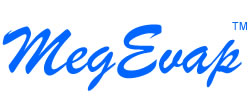|
One of the major benefits of evaporative cooling is the reduction (or
elimination) of refrigeration compressor horsepower required to condition
outside air. In applications where conditioned outside air is required
for ventilation operating costs can be reduced by as much as 80% .Often
this can be achieved simply and economically with the addition of an evaporative
wet section on the fresh air intake of an existing air handling or ventilation
system utilizing fans or blowers already in place.
In a situation where a 10,000 CFM supply air stream needed to be taken
from 90 degrees F. and 25% R.H. to 67.5 degrees F. it would require roughly
25 compressor horsepower using conventional refrigeration air conditioning.
The power required to achieve that same 22.5 degree drop through a MegEvap™
evaporative wet section is 1/6 horsepower. It’s easy to see how fast
savings can accumulate. Evaporative cooling is a very attractive alternative
to air conditioning in many applications, it’s low cost of operation
and maintenance even make it possible to condition areas thought to be
too expensive or too large to cool in the past. Some prime candidates
for evaporative systems are manufacturing facilities, warehouses, prisons,
repair and welding shops, machine rooms, stock confinement areas, milk
barns, poultry houses, winery barrel rooms, packing sheds and produce
operations.
Along with the other benefits evaporative cooling has to offer is very effective
air filtration. Contaminants in the air stream are forced against the wet
surfaces on the interior of the rigid media where they are trapped much
like an insect on fly paper. From there, because of the self cleaning design
of the media the contaminants are washed to the sump where they are easily
flushed. The larger particulates can be filtered before they enter the media
with the addition of optional pre-filters. An evaporative system will effectively
filter spores, pollen, dust, smoke and other particulates. They will even
reduce water soluble VOCs and atmospheric pollutants such as CO, CO2, SO2,
and Nox gases resulting in a significant improvement in air quality. Simply
put the air coming out is better than the air going in.
A business utilizing a MegEvap™ evaporative system will be viewed as
making an effort to reduce pollution and greenhouse gases. By reducing operating
time on conventional refrigeration systems generated power requirements
are consequently reduced along with the risk of CFC release. Reduced time
on refrigeration compressors as well as a reduction in the associated maintenance
and the extension of the useful life of the equipment is also worth consideration.
The fact that any maintenance on an evaporative system can be performed
quite easily by unskilled labor is also an advantage over conventional cooling
equipment. Another possible benefit for facilities that reduce energy consumption
through the use of evaporative cooling is energy rebates from participating
power companies. The use of refrigeration condenser pre-coolers can be considered
a form of electrical peak shaving as they provide the greatest energy savings
during the hottest time of the day when electrical demand is highest. Evaporative
cooling is considered a "green " technology.
Here are some common evaporative cooling formulas that maybe helpful in
calculating the effectiveness and/or size of system you need.
Evaporative (Direct) Effectiveness:
E = (Tedb - Tldb)
/ (Tedb - Tewb)
x 100
Tedb = Temperature Entering Media,
Dry Bulb °F
Tldb = Temperature Leaving Media,
Dry Bulb °F
Tewb = Temperature Entering Media,
Wet Bulb °F
Water Evaporation Rate Estimate:
Gallons per minute = V x (Tedb
- Tldb) / 500,000
V = Air Volume in cubic feet per minute (cfm)
Tedb = Temperature Entering Media, Dry
Bulb °F
Tldb = Temperature Leaving Media,
Dry Bulb °F
Rule of Thumb Air Volume Requirement:
Air Volume, V = Ls x Ws
x Hs x (ACs
/ 60)
Ls = Length of Space to be cooled
(ft)
Ws = Width of Space to be cooled
(ft)
Hs = Height of Space to be cooled
(ft)
ACs = Air changes of space
per hour (typically, 15 to 20) |





